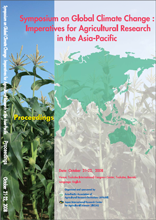Challenge Program on Climate Change

The World Development Report (2008) concludes that Climate Change (CC) will have far
reaching consequences for agriculture that will disproportionally affect the poor. We are seeing some
of the beginnings already ? greater climatic risks that are imposing economic losses and undermining
food security. Enhancement of adaptation measures is urgently needed to reduce these risks facilitated
by international, national and local action. Agriculture is also a contributor to CC; there are
opportunities to harness the untapped potentials of agriculture to reduce emissions.
The Consultative Group for International Agriculture Research (CGIAR) Centers and their
numerous National Agriculture Research System (NARES) partners in government and civil society
organizations have been helping farmers cope with the effects of variable and severe weather for
nearly three decades. They have generated a wealth of improved crop germplasm, knowledge,
technologies, methods and policy analysis, which can lessen the vulnerability of marginalized rural
people and places through more sustainable management of crops, livestock, soils, water, forests,
fisheries and biodiversity. They also undertake research to mitigate against climate change (CC) gases
particularly through policies on sustainable forestry, acquisition of C in tree and crop systems, reduced
N20 and methane gas emissions and on gathering scientific data to facilitate various systems for
payment of environmental service (PES).
This work has largely been undertaken without full engagement with scientists dealing with
Global Environment Change (GEC) whose research is structured around 4 international research
programmes: DIVERISTAS (biodiversity)1, IGBP (biogeochemistry)2, IHDP (human dimensions,
social sciences)3 & WCRP (climate sciences)4. These four Programmes have come together to form
the Earth Systems Science Partnership (ESSP).
The concept of the CGIAR “Challenge Program” (CP) was to bring together the right partners to
address a major global challenge with a focus on outcomes in a fixed time frame.5 The soon-to-beformed
and new CP “Climate Change, Agriculture and Food Security (CCCP)” does just that. The
global challenge is known to all of us; because so many of the rural poor in developing countries
depend on agriculture, it is one of the central arenas in which the threat posed by climate change must
be confronted. The efforts of CGIAR and NARES can provide part of the basis for action, but they
must be more sharply focused on the predicted and most vulnerable and better coordinated. The ESSP
partner brings that dimension.
The CCCP’s main objectives are (i) to close the critical gasp in knowledge on the nexus of food
security, livelihood and environmental outcomes in the face of CC, (ii) to develop and evaluate
options for adapting to CC for agriculture development and to inform policy and development
strategies and (iii) to assist farmers, policy makers, researchers and donors to monitor, access and
adjust their actions in response to CC.
The work in the initial phase will be at three (3) focus regions ? East Africa, West Africa and
Indo-Gangetic Plain selected based on the criteria of (i) poverty and vulnerability, (ii) complimentary
set of social, cultural and institutional contexts, (iii) complimentary climatic contexts with different
temporal and spatial scales of climate variability and degree of predictability, (iv) significant but
contrasting climate-related problems and opportunities for intervention and (v) governance and
institutional capacity that favour likelihood of generating transferrable results. Within each region
1 http://www.diversitas‐international.org/
2 http://www.igbp.net/
3 http://www.ihdp.unu.edu/
4 http://wcrp.wmo.int/wcrp‐index.html
5 http://www.cgiar.org/impact/challenge/index.html work will be undertaken at sites selected along a gradient of (a) anticipated temperature and
precipitation change, (b) current and predicted land use pressure and (c) different land tenure and
institutional arrangements. An example of the planned cross sector sites is show in Fig.1 for the Indo-
Gangetic Plain region.
Success hinges on maintaining the active involvement of all three communities?CGIAR, NARES
and GEC (and their respective donors) so as to effectively address the niche of the interface and the
‘added value” among their respective agendas. The CCCP is not aimed at “business as usual” for any
one group; getting this focus is crucial. The CP also has an ethical responsibility that it must clearly
define what part of the global challenge it can address and what outputs and plausible outcomes it can
deliver in the time frames of the CP.
In addition to the scientific and developmental potential from the “added value” through the
Partners, the CP also offers efficiencies in financing. The research of the GEC is typically funded by
science agencies (e.g. research councils, etc) and the research for development of the CGIAR by
development agencies. The CP has the potentially to interest both investors.
| 刊行年月日 | |
|---|---|
| 作成者 | Kenneth S. Fischer |
| 著者キーワード |
Adaptation Mitigation Agriculture Global Environmental Sciences Poverty |
| 公開者 | Japan International Research Center for Agricultural Sciences |
| オンライン掲載日 | |
| 号 | 2008 |
| 開始ページ | 164 |
| 終了ページ | 171 |
| 権利 | Japan International Research Center for Agricultural Sciences |
| 言語 | eng |
